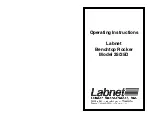
Ether232
Plus
User Guide
4 Configuring the Serial Port Settings
02-CML000057
Precidia Technologies Inc.
23
Telnet
Turns the Ether232
Plus
into either a telnet client (most common
use) or a telnet server and allows the user to telnet out of the
Ether232
Plus
to a remote server, such as a UNIX workstation.
The standard connection control options are supported. By leaving
the
Connection Control
parameter at Automatic (default setting),
the user can initiate the telnet session by pressing any alphanumeric
key. If the
Connection Control
parameter is set to DTR/DSR Con-
trol, the Ether232
Plus
tries to open a telnet session as soon as DSR
is detected from the terminal, but the timeout function of most hosts
makes this option somewhat unreliable.
Telnet-Client:
The most common use of the telnet protocol. To cre-
ate a telnet client, select
tcp-client
as the session mode. This config-
uration allows the Ether232
Plus
to communicate with the telnet
server at the configured Remote IP address and Remote Port.
Telnet-Server:
To create a telnet server, select
tcp-server
as the
session mode when configuring this protocol. The Ether232
Plus
lis-
tens on port 23, and the Remote Password must be disabled so that
the standard configuration program is not listening on that port. You
can still use a Remote Password by configuring Telnet to listen on a
port other than 23 (but above 1024 to avoid using reserved ports).
Transparent
Typical setting. No alterations are made to the data stream, nor is it
parsed in any way. Data is collected until either the preferred packet
size is reached or there is a pause between characters that exceeds
the inter-character timer. The buffer is then transmitted as a single
frame.
Preferred Packet Size
and
Max Inter-Char Delay
can be left
at the default settings (0), and the unit will automatically determine
a reasonable setting based on the current serial port speed.
Transparent protocol includes the option
Packet Prefix
, which
allows you to include a header in the packet defining it’s length. See
Section 4.12, Packet Prefix (Transparent Protocol Only)‚ on
page 35.
Table 4.1: Data Formatting Options
Menu Item
Description
















































